Since Maya and 33(11)'s return to Rutland, we had been excitedly waiting for signs of this years clutch and, on Tuesday 4th April at 16:15, we were treated to the wonderful sight of the first Manton Bay egg and this was just the beginning. Three days later, on Friday 7th April, we had the first glimpse of the second egg and a further three days later on Monday 10th April, we saw the third. Typically we'd suggest that three was an excellent number of eggs for any experienced breeding pair of Ospreys, but we started to speculate that we might see a fourth when Maya was seen delaying the incubation of the already laid eggs. Sure enough, on Thursday 13th April, we were delighted to see that Maya had laid the fourth egg, something considered to be extremely rare with osprey breeding pairs. This season will be the fourth time they will attempt to raise a brood of four.
Great Egg-Spectations
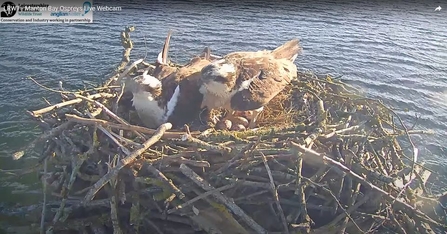
Maya revealed that she'd laid the fourth egg on 13th April
After the eggs are laid, it takes about 35-42 days of incubation before we see them hatch. It is typical for the female of the pair to incubate the eggs for the majority of the time while the male will spend more time fishing and protecting the nest site from intruder. One of our visitors, Ray Kilham, took a fantastic picture of 33(11) mid-dive (see below) from one of our hides here at Lyndon. It's brilliant to be able to see him in action!
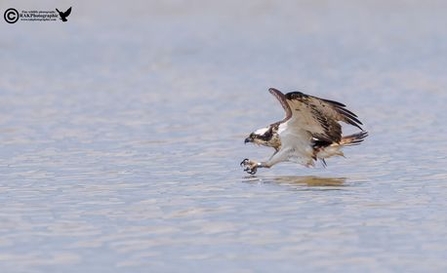
It's brilliant to see 33(11) in action, fishing in Manton Bay (Photo Credit: Ray Kilham)
Some may remember the intruder to the Manton Bay nest at the start of the season, 25(10) and lot's of people have asked for an update on her. After she was chased off by Maya, she was seen on one of our other nest sites, trying to breed with male 6K(14) (who we'll mention a bit later), before finally returning to her regular nesting site with her long-term breeding partner, 11(10). She is now incubating on that site and, given the time the incubation started, it seems very likely that only her mating attempts with 11(10) have been successful.
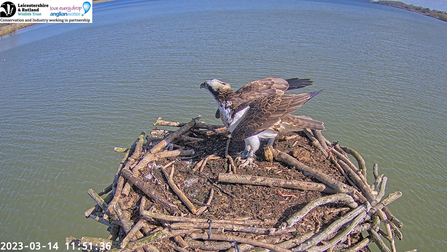
While the best views of nesting ospreys in Rutland may be found at the hides at Lyndon, some of the local birds have been seen from the Egleton site as well. One of our breeding males 6K(14) has been frequently seen in flight (and sometimes with fish) near the Anglian Water Birdwatching Centre. 6K(14) has been breeding with 5N(04) (Leicestershire and Rutland’s oldest breeding female) since 2020. They have had 9 juveniles successfully fledge over those three years. 6K(14) fledged in 2014 from site B and was one of the juveniles of the final brood to be parented by male 03(97) (or Mr Rutland, arguably our most significant breeding male ever) and his unringed female partner. One of our visitors, Lynda Schlemmer, managed to get a great shot of him flying over the Nature Reserve with a fish (see below).
6K(14) has been frequently seen over the Nature Reserve recently (Photo Credit: Lynda Schlemmer)
As we speak of 6K(14), it is now time to unfortunately note the absence of his breeding partner 5N(04). 5N(04), as previously mentioned, was the oldest and most successful breeding female in the Leicestershire and Rutland population, having raised 34 juveniles since she first bred here in 2009. We have now deemed it too late to expect her to arrive this season, and that 2022 would have been her last breeding season. While we will miss having her in our population, we take solace in knowing that we can follow the progress of her offspring. 1K(13), one of her juveniles has been breeding in the local area since 2018 and is back with his partner on his nesting site this year.
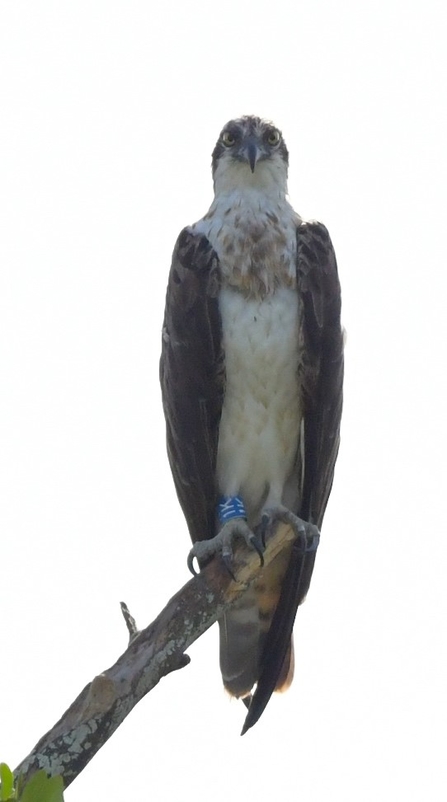
1K photographed in southern Senegal (Photo Credits: Joanna Dailey)
Another notable absence from the returning ospreys this year is 4K(13). 4K(13) was the last of our radio tracked Rutland ospreys, and just last year we were delighted to see him have his first successful nest on the Belvoir Estate, raising two chicks. Towards the end of February, we stopped receiving data from his radio tracker and, while we tried to remain optimistic that this was simply just a technical fault, we now feel that it would be very late for him to return and assume that he must have died. It's a shame to have lost him just as he established a breeding site but we'll keep an eye out for his two juveniles in the coming years to see if they return.
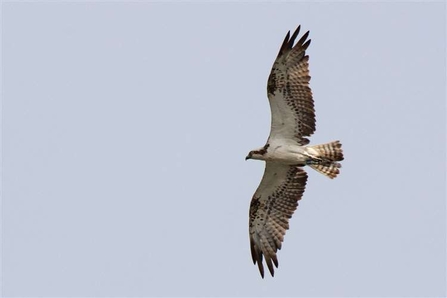
4K(13) was seen in West Africa by the Conservation Without Borders team in 2022 (Photo Credit: Conservation Without Borders)
To finish on a much cheerier note, we have some absolutely fantastic news. 095(21) (one of the two Manton Bay fledglings from 2021) has been recorded intruding on one of the Kielder nest sites at 1:51pm on Thursday 28th April. She has since been seen on another nest where one of their unringed males has been looking for a mate. All being well, it could be that we see her having her own brood up there in the coming years.
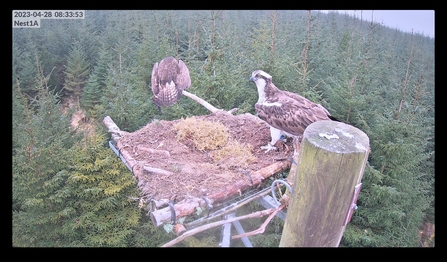
095(21) was seen intruding on the Kielder nest and then seen on Nest 1A (Photo Credit: Forestry England)

